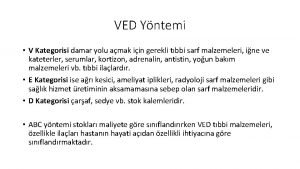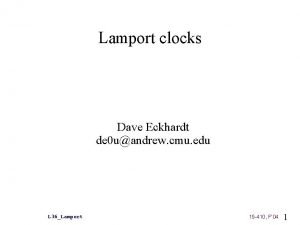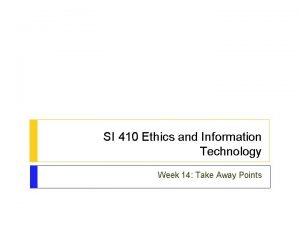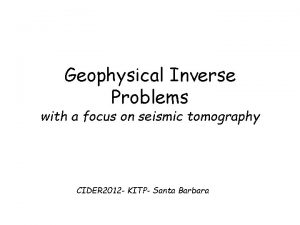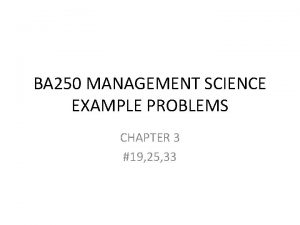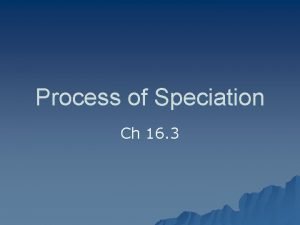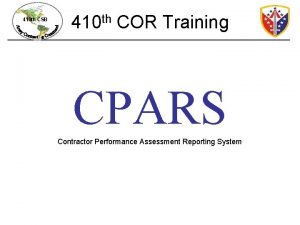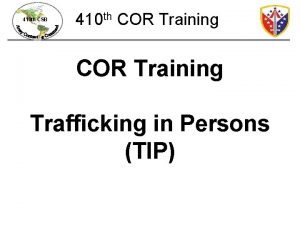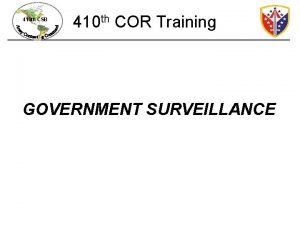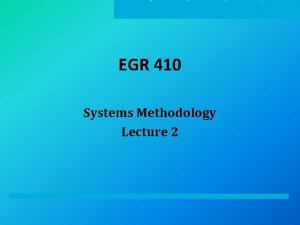Data Structures and Analysis COMP 410 David Stotts



























- Slides: 27

Data Structures and Analysis (COMP 410) David Stotts Computer Science Department UNC Chapel Hill

Basic Graph Theory (part 1)

Definitions Graph is not a picture or a chart Mathematical structure based in sets and relations/functions G = ( V, E ) where V is a set of vertices (nodes) E is a set of edges (arcs) E is a set of ordered pairs E = { (a, b) | a ∈ V ∧ b ∈ V } �directed graph E is a set of sets, E = { {a, b} | a ∈ V ∧ b ∈ V } �undirected graph We let edges represent (model) different things… ◦ road from a to b, a is parent of b, a employs b ◦ a must be taken before b, a explains b, …

Directed Graph adjacent we say b is adjacent to a iff (a, b) ∈ E directed graph edges in E are directional pairs in E are ordered draw with arrows we say “digraph” (a, b) ∈ E a b Example V = { a, b, c, d } E = { (a, b), (b, c), (c, a), (c, d), (d, b) } so G = ( { a, b, c, d }, { (a, b), (b, c), (c, a), (c, d), (d, b) } ) a b c d

Undirected Graph Edges have no direction If b is adjacent to a, then a is also adjacent to b Elements in E are sets, not ordered pairs We say a is adjacent to b, AND b is adjacent to a {a, b} ∈ E a b Example V = { a, b, c, d } a b E = { {a, b}, {a, c}, {b, d} } G = ( V, E ) c d

Undirected Graph Symmetry: (a, b) ∈ E ∧ (b, a) ∈ E Not so here… only one edge b a This … This is shaking hands a b not the same as this … This is hand on the shoulder If a shakes b’s hand, It is impossible for b not to shake a’s hand

Weighted Edges Some problems may need a “weight” associated with each edge 2 a 4 b a 5 b E = { (s, d, w) | s∈V ∧ d∈V ∧ w∈Int } or weights might be real Unweighted graphs can be thought of as having weight of 1 on each edge

Path � b Here ( b, b ) ∈ E So there is a path b to b that has length 1 c d

Simple, Cycle � a b c d

Cycle in Undirected Graph We require the edges to be distinct If (a, b) ∈ E there is no cycle between a and b per se a, b, a is not a cycle, that would imply an edge (a, b) and another edge (b, a)… (path length 2) but these are one edge, the same edge a b Another reason these are technically not the same a b

Cycle in Undirected Graph We require the edges to be distinct a b No cycles in this graph c a b c cycles now… a, b, c, a, b etc. cycles in this one a, b, a, c, a, b etc.

DAG DAG: Directed Acyclic Graph Special form used in many problems Directed edges No cycles. . . DAG a a b b e c e d c d f f Directed edges But cycles ? Yes, so not a DAG

DAG We have been using DAG’s already… Anyone? Trees b a c Directed edges No cycles. . . DAG e d h i We often use directed edges because the parentchild relation is one-way, not symmetric f g

Graph Algorithms Lets go back to the previous DAG example How can we answer the question “ Is there a cycle? ” Directed edges But cycles ? a Now? b e No… a DAG Cycles… not a DAG Graph Algorithm: For each vertex v { c d No… a DAG f trace paths from v see if you revisit a node on the path each path must end or revisit (why? )

Connected Undirected Graph Has a path from every vertex to every other vertex a a b b e e c c d connected f d Not connected f

Connected Directed Graph Strongly Connected: Has a path from every vertex to every other vertex a d b c Strongly connected Not strongly connected

Connected Directed Graph Weakly Connected: underlying undirected graph is connected a b d a d b c Underlying undirected graph c Not strongly connected This is weakly connected this is connected so …

a More Examples s. c. yes so also a w. c. yes s. c. no w. c. yes c b b a c e w. c. no d b c so also s. c. no we just say not connected

Complete Graph � K 1 K 2 K 4 (4*3)/2 = 6 edges K 5 N nodes, N(N-1) ------- edges 2 K 3 K 6 (6*5)/2 = 15 edges

Planar Graph All edges can be drawn on a plane with none crossing This earlier graph is planar K 3 is planar K 4 planar?

Planar Graph May be planar, but drawn poorly Determining planarity is important Redraw of the crossing on boards in laying outone VLSI circuits edges, “rubber-band” it outside the others Metal “wires” cant cross So here’s another K 4 algorithm… graph given graph G, is it planar? Have to solve this by wandering around in data structures for V, E you don’t have a drawing K 4 is planar

What about K 5? Planar Graph K 5 not planar Turns out that K 4 is the largest complete graph that is planar No matter which inner edge you “stretch” you get a cross

Planar Graph So rule of thumb… This graph “drawing” looks not planar… The graph might still be planar… it just might be drawn poorly to show that This graph “drawing” looks planar… so the graph IS planar A graph is not the drawing… a graph is the math object

Bipartite Graph Nodes are in two disjoint sets (types), and every edge connects different type nodes is bipartite still is … is bipartite not bipartite but now not

More Bipartite Can think of bipartite as colorable with 2 colors Every edge goes between the 2 color collections e a a b d b c g f c is bipartite d e f g

More Bipartite Tree is an acyclic graph. Prove it is bipartite By induction on #nodes N b Base: 1 node, just color it B a c e d k h j i f g Inductive Hypothesis: Every tree T with N nodes is bipartite. Inductive Step: Show that T’ with N+1 nodes is bipartite. Consider T = T’ less a leaf node v. T is a tree, and T has N nodes, and so by IH is bipartite. Node v in T’ has one neighbor (its parent); whatever the color of the parent is, assign v the other color. Then the arc between p and v is an arc connecting different color nodes. Node v is not part of any other edge. Therefore, T’ has N+1 nodes is also bipartite.

 Comp 410
Comp 410 Homologous structures example
Homologous structures example Cs 410 uiuc
Cs 410 uiuc Ved yöntemi nedir
Ved yöntemi nedir Single key loader
Single key loader Cmu 15-410
Cmu 15-410 Iat 410
Iat 410 Si-410
Si-410 Si-410
Si-410 6-12/410
6-12/410 Akar dari 410
Akar dari 410 The bradley family owns 410 acres
The bradley family owns 410 acres Cross projection sketch
Cross projection sketch 16-3 the process of speciation
16-3 the process of speciation Ipm 410-3 (shikha) price
Ipm 410-3 (shikha) price Svsd 410
Svsd 410 Si 410
Si 410 Buss 410
Buss 410 Alunda innebandy
Alunda innebandy Cse 410
Cse 410 Cpsc 410
Cpsc 410 Barracuda web filter 410
Barracuda web filter 410 Hotel math fundamentals
Hotel math fundamentals Data structures and algorithms iit bombay
Data structures and algorithms iit bombay Amit agarwal princeton
Amit agarwal princeton Data structures and algorithms tutorial
Data structures and algorithms tutorial Define macro processor
Define macro processor Assembler algorithm and data structures
Assembler algorithm and data structures



